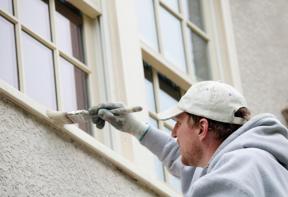Painting outside
Make your paint job last longer
Although a long-running decor disagreement might have you feeling otherwise, when it comes to exterior painting, finding the right colour really is the easy part. Selecting the right primer and paint formulation is the tricky bit. I’ve found that the best people to ask for advice when choosing paint are the professionals who mix and sell to the painting trade. They will have the experience to steer you clear of combinations thatwon’t work, and they should be able to tell you which products have a proven history of performing well where you live. While it’s difficult to show that any one brand of paint is superior to any other, it is generally the case that high-quality paint is more expensive than lower-quality paint, and in terms of ease of application, coverage and durability, generally you get what you pay for.
Proper prep
Before you dip your brush, of course, there’s always prep work to do. Dirt and oxidation will challenge the new paint’s ability to stick, so clean thoroughly with trisodium phosphate (TSP) or a lightpower washing. (Always rinse with clean water and let dry thoroughly.)
New paint prefers to be laid down over a sound surface, so you have to scrape, strip or sand away loose old paint. It’s not always necessary to get down to bare wood, but any underlying paint needs to adhere well to the substrate. Houses painted before the 1980s will more than likely have lead-based paint on their surfaces, so it is imperative that the dust and scrapings be contained and that you wear a proper respirator. Do not sand asbestos shingle siding. Nails should be set below the surface if necessary, and exterior-grade spackle or putty should be applied, sanded and primed. Any new or replacement trim work should also be primed on all sides to resist moisture penetration. Gaps and cracks should be caulked with a quality, paintable sealant, preferably one that advertises itself as a elastomeric or stretchy, to handle expansion and contraction owing to temperature fluctuations. Instead of piling tube after tube of caulk into a large seam, fill it with foam crack-stuffer material from the hardware store first.
Oil or latex?
On the question of oil versus latex, there are really no easy answers. Ask your paint supplier for advice. Some materials, such as resinous red cedar siding, require an oil- or shellac-based primer, but then may be followed quite successfully by a latex colour coat. I prefer oil paints for exterior trim work, because I like the hardness and sheen developed by a quality gloss or semi-gloss exterior oil-based paint. But for the body of the house, the ease of use of a low-sheen latex can’t be beat. One thing is certain: don’t skip priming. A primer coat is necessary for the colour coats to adhere to the substrate, and it will mean the difference between a job that is durable and one that fails in a short time.
To leave a comment, please log in












No comments